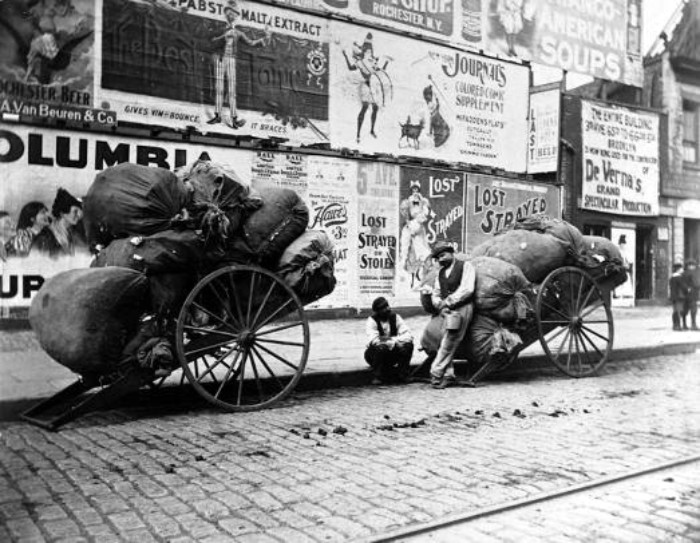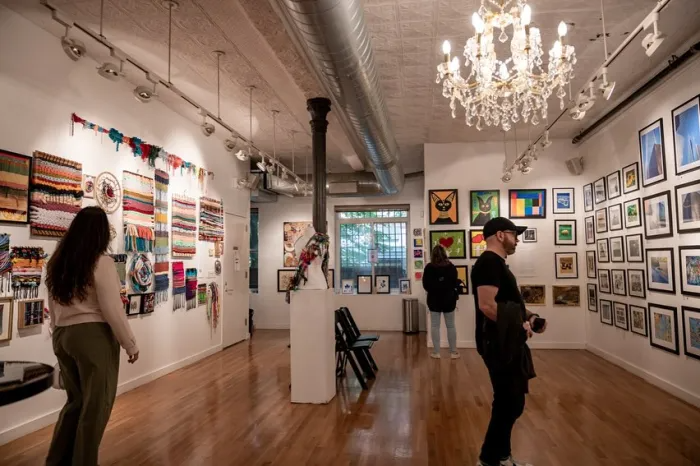Walkabout: Brooklyn, Through Rag and Bone
Read Part 2 of this story. The story of Brooklyn is a story of immigrant success. Beginning with the Dutch in the 17th century, Europeans have come here, worked hard to carve lives for themselves and families, and most have prospered and thrived. Some groups did better than others. Some groups were wanted, others were…


Read Part 2 of this story.
The story of Brooklyn is a story of immigrant success. Beginning with the Dutch in the 17th century, Europeans have come here, worked hard to carve lives for themselves and families, and most have prospered and thrived. Some groups did better than others. Some groups were wanted, others were not.
All in all, a complicated mixture of nationality, drive, skills, language, bigotry, religion, acceptance, political opportunity and a dash of luck have resulted in the polyglot mosaic that makes up the American experience.
Unfortunately, human society is built on class and caste, no matter how egalitarian we may boast of being, and someone is always going to be on the bottom. For centuries the bottom was reserved for black people who were brought here as slaves. The end of slavery meant menial work for most, and equality for very few. It would take many more centuries to change that impression, and the job still isn’t done. When large amounts of Europeans began immigrating to the US, room had to be made on the bottom for new groups.
By the end of the 19th century, the newspapers echoed many in American urban society who wondered why, if we had to have immigrants, more Northern Europeans didn’t come here? They had few problems with the English, Germans, Norwegians, Swedes, Danes and Dutch. They were hard working and industrious, and eager to become Americans.
The French, Spanish and Portuguese were not a huge presence in New York City, and they were alright, too. It was the rest of them they objected to– first the Irish, then the Poles, Hungarians and other Eastern Europeans, along with the millions of Italians and Eastern European Jews. Especially the Italians and Eastern European Jews.
They crowded into the slums of Manhattan and Brooklyn. They were so foreign, they could have been from another planet. They could not, and would not speak, or learn how to speak English. They ate foreign foods, had foreign cultural habits, were more Catholic than even the Irish Catholics, or more Jewish than the German Jews who were already here and doing well.
They had too many children, too few skills, and lived in the worst conditions imaginable, and seemed to like it. They couldn’t get jobs, or didn’t want to work. They were so beaten down by their horrible lives; they just sat in their dirt and filth, and stared at reporters and officials with sullen, dead glances. They were incomprehensible.
The Italians were a special mystery to upper class New Yorkers. They knew Italy from their studies and travels as the cradle of Western Civilization. Italy gave the world the power of the Roman Empire and the glories of the Renaissance. The upper classes made pilgrimages to Italy to visit Rome, Florence and Venice, where they marveled over the art, architecture and music of this most temperate climate.
Italy was the beauty of Tuscany, it was the home of Romeo and Juliette, opera, sculpture and art. Its people were friendly, clean and fashionable, although quite foreign, of course, but colorful and talented. Even in the countryside, the people worked in vineyards and olive groves, and cooked wonderful food and lived in villas. Everyone was happy to see American tourists, who just loved everything and everyone Italian.
So what happened? Who were these Italian people crowding into slums? They didn’t even look like the Italians they were familiar with. They didn’t speak the beautiful Italian they heard in Rome or Florence. They were dark and swarthy and poor and foreign. Where were “their” Italians?
They would have been welcome, not these people. These were the southern Italians, from Naples and Sicily. They were poor peasants, clannish and secretive. Northern Italians couldn’t even understand them; their speech was an incomprehensible collection of dialects. Why, some of them were so poor they were scraping out a living by going through the trash. These Italians, many of them, were actually rag pickers.
The French have a word – “Chiffonierre.” It’s a lovely word to describe one of mankind’s oldest professions; trash pickers. The English call them rag and bone men, Americans called them trash grubbers and rag pickers.
As long as there have been cities, there have been people who made a meager living from going through other people’s trash, and gathering anything that could be reused or resold. Rags and clothing, pieces of metal, broken china and glass, even bones, all were marketable goods for someone.
In Manhattan and Brooklyn, towards the end of the 19th century, the profession of rag picker had fallen to the Italians. They made up most, although not all, of New York’s rag pickers, and there were hundreds, perhaps thousands of them. They lived in all of the city’s worst slums, and in both cities, there were certain neighborhoods that were predominantly occupied by families in that profession.
The rag pickers were usually men. They would bring whatever they found home for women and children to separate and gather together, but wandering the streets in search of goods generally fell to the men. They usually went out with a sack slung over their shoulders, with the more successful able to afford a hand cart.
Rag pickers literally picked up rags. Cloth fibers were used in paper production, wall paper, and cardboard. Old clothing could be picked apart for buttons and notions, or reworked into new clothing, or used for stuffing quilts or the quilts themselves. Nothing went to waste. Broken china and crockery could be ground up for reuse. Glass and metal of any kind could be melted down. Even bones were good to collect. They could be ground down to powder for binders in china and other substances, and larger bones could be made into knife handles, toys, or used in chemistry.
The rag pickers were not involved in the end use of the things they collected. They would collect as much as they could and then sell their wares to the “master rag picker”, a middleman who would sell to manufacturers of all kinds. The rag picker did all the work, and of course, got the least in return for his labors.
The picker got pennies for the pound, the middlemen even more, on up the chain of production. There are photographs of the rag pickers with large cloth bags of rags, gathered for the wholesaler. It took a lot of time and work to get that many rags together.
At the end of his day, the picker went home with his hoard. But the job was not done. The rags that were to be sold could not be wet and filthy. They had to be clean and dry. As social reformers, the police, and other observers of slums conditions would report, the homes of rag pickers were filled with wet rags hanging everywhere to dry.
Their homes were pretty awful anyway, but made even worse by damp rags dripping on everything and everyone. Slum quarters, in general, got no light, so there was little opportunity for wet rags to dry in the sun. This caused not only clutter and mess, it was dangerous.
The field of public health was in its infancy when it had to be ramped up because of the conditions of the poor in 19th century urban America. Rag pickers were out in the trash picking up dirty rags. They brought these rags back into their poorly ventilated homes and had their wives and children handling them, washing them and hanging them everywhere to dry.
The amount of disease was staggering. Smallpox, tuberculosis and other communicable diseases were all over this stuff. Children were handing filthy rags from who knows where, and hanging them over their heads while they slept.
Rags were rags. Better-off people had used them to clean, they were used in industry, and now they were in the trash. They were often covered in excrement and bugs, and they were filthy beyond belief. But they were valuable, and if one rag picker found them to be too disgusting, there was another who did not. It was money; it was survival, pure and simple. The same could be said for bones. Dead cats and dogs were not beyond salvaging either, for their pelts and bones.
Here in Brooklyn, there were several places where groups of rag pickers lived. They were regarded to be the worst of the worst places in the city. They were in some of the oldest tenement slum areas. One area was in the First Ward, on Adams, Front, Pearl, Main and Water Streets, in what is now Dumbo.
In 1884, this area was filled with wood-framed tenement buildings. A large group of Italian rag pickers and their families lived in this area, the basements of the tenements filled with rags and refuse collected for resale. The conditions here were appalling.
The other large gathering of rag pickers was in Gowanus, centered around Whitwell Place, near First and Carroll Streets. This was also an Italian neighborhood, and had the largest group of rag pickers in Brooklyn living here. Public health officials, along with the police and the press, came here a lot.
There were reports generated by public agencies, and a lot of press reports. The literature written about all of the Italian rag picker colonies was full of prejudice, judgmental bigotry, and stereotypes. Most of it boiled down to “the conditions are awful, but the Italians love it, and wouldn’t have it any other way. These people are incomprehensible.”
Next time: a closer look at the Brooklyn rag picker’s world.
(Photograph: NYC rag pickers. 1896, by Alice Austen, photographer)









What's Your Take? Leave a Comment